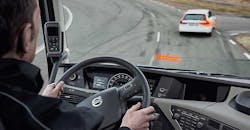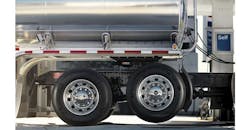Volvo making its trucks smarter and safer to help boost customers’ businesses, keep drivers on the road
VOLVO has your back.
That was the message Chris Stadler, a product marketing manager for Volvo Trucks North America, delivered to tank truck carriers and drivers during his presentation “Equipment Trends for Tank Truck Operations” at the National Tank Truck Carriers’ Tank Truck Week 2018 in Nashville, Tennessee.
Stadler touched on Volvo Trucks’ endless efforts to improve its trucks in the areas of emerging technology (eg remote diagnostics and programming); and driver safety (Volvo Active Driver Assist), productivity and comfort, highlighted by its recently introduced “ergonomically advanced” workstations.
The company’s goal, he maintained, besides keeping drivers and trucks on the road, is to help customers improve their businesses by decreasing downtime, and increasing efficiency and driver loyalty.
“All the technology we work with is going to help attract new drivers, and also make the experienced drivers more comfortable while being on the road, and retain them for a longer period of time, because we all know right now there is a driver shortage and drivers are hard to come by,” Stadler said.
Driving business
Truck technology is evolving rapidly, customers want to know what’s happening, why it matters and how it will impact their business, and Volvo wants to address those concerns, Stadler said, so the company always is assessing how best to leverage the latest advancements to ease their minds.
“We have to answer those questions before they get in the door,” he said.
“We’ve got to know what they need … because that’s what we do—everything we can to help improve their business.”
What carriers need most these days are drivers.
Stadler, who holds a commercial driver’s license, said he respects these hard-working professionals—of which tanker drivers are among the best—and recognizes their importance in moving the economy, as does Volvo, thus its support of the American Trucking Associations’ America’s Road Team.
To show their appreciation, Volvo in February expanded availability of its upgraded workstations, redesigned to improve the productivity, comfort and convenience of drivers’ rolling homes.
The company also loads its trucks with “premium driving comfort” features, including extensive steering wheel controls, improved information display units and power supplies, and automated transmissions.
“When we look at different areas of the truck, we break it down for the drivers when it comes to the driving environment and the living environment,” Stadler said. “How can we bring new technology into those areas and help them be better at their job and safe while they’re on the road?
“And we paid specific attention to what they need to do their job.”
Sharing the load
As with any tool, having the right truck for the right job is essential, so Volvo pays close attention to how its trucks are used, Stadler said, including the type of trailer and the product they’re hauling, while also keeping in mind a truck may serve more than one master during its lifetime.
With this in mind, Volvo developed its adaptive loading system that automatically switches between 6x2 and 4x2 drive-axle configurations using a forward axle that lifts tires off the ground, and boasts electronic controls, traction-refining capabilities and the option to integrate with other tech.
Stadler said 6x2 benefits include lower rolling resistance, boosted by an optimized tire package on the lift axle, for improved fuel efficiency; maintenance savings, through reduced brake and tire replacement on the forward axle; and hauling flexibility—with the right number of axles for the load.
“In this bulk hauling market … capacity is a big necessity,” Stadler said. “(Carriers) want to have additional capacity to carry more loads and deliver that product.”
Volvo Trucks also is pursuing advancements in connectivity, electromobility and automation through partnerships with key suppliers and customers, Stadler said, including the Low Impact Green Heavy Transport Solutions (LIGHTS) project in California, and its platooning project with FedEx.
“I don’t see electromobility and automation making a big impact in the tanker market at this time,” Stadler said. “But I do recommend customers in that market pay attention and watch closely as they get further along in development, and in our understanding of what we can do for the market.”
The biggest opportunity for tank operations is in connected services, he said.
Volvo is focused on leveraging its trucks for connectivity in three areas: remote diagnostics, for proactive monitoring of powertrain components; remote programming, for on-the-road software updates that keep trucks in service, potentially decreasing downtime; and integrated fleet management.
“All of that is coming on board and coming quickly,” Stadler said. “So it’s not only impacting your trucks today, but it’s going to impact them even further as we progress with that type of technology.”
Safety technology
A key emphasis for any company, but particularly those in the tanker market, is on keeping drivers safe, along with the products they’re hauling and environments they’re inhabiting, in case of a spill.
Volvo spent years investing in passive safety technologies, Stadler said, but now it’s aggressively pursuing active safety tech in hopes of avoiding collisions, instead of mitigating the repercussions.
“What we’ve done is introduce Active Driver Assist,” he said.
“It’s the latest generation of forward collision avoidance technology. It’s also very important to us because safety is our core value today, and we put it standard on every vehicle as it goes out the door.”
Volvo’s Active Driver Assist combines camera and radar technology to track and prioritize surrounding vehicles, and alert the driver to the most critical situations. The system can disengage cruise control, reduce throttle, engage engine braking, downshift and apply service brakes.
Stadler said the company also wants to continue advancing safety technologies by adding more actionable alerts and notifications, such as a heads-up collision alert that displays a red line on the windshield.
“Safety systems are important and should be a proper investment for you as a customer, especially in this tanker industry today, because we all know these are critical components that are being delivered down the road,” Stadler said.
“Our vision is no truck is involved in a traffic accident. That’s our goal—to have zero accidents—and to realize this vision, we need to continue to develop the products and systems that prevent accidents from happening.”
About the Author
Jason McDaniel
Jason McDaniel, based in the Houston TX area, has more than 20 years of experience as an award-winning journalist. He spent 15 writing and editing for daily newspapers, including the Houston Chronicle, and began covering the commercial vehicle industry in 2018. He was named editor of Bulk Transporter and Refrigerated Transporter magazines in July 2020.


